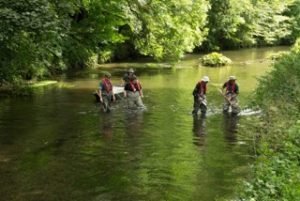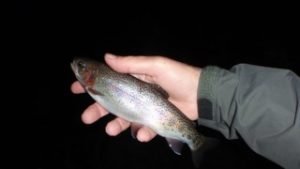Fishing Report – 18 September 2017
Cressbrook & Litton Flyfishers – Fishing Report 18 September 2017
I’m not sure why August has such a bad reputation as a fishing month. My last few visits have been wonderful. The river has been in good order, if a little on the low side, and the weather settled and perfect. Olives have hatched, caddis too, loads of crane flies and now the late season olives and stoneflies are on the wing.
After an excellent fish supper from the Corner Chippy in Tideswell, courtesy of the EHK, I started to work my way up from the top of Duffers. There were a few olives hatching and a size 20 Plume Tip was immediately of interest. I was using my Sunray 10 foot 2 weight, which increasingly is my weapon of choice both here and on the Derwent. It has a lovely through action and is very forgiving when the hook is set. It encourages you to feel for the fish rather than to strike, yet it seems to have the backbone to subdue larger fish.
I had a fish or two from the shallows then stepped over the weir into the Dinosaur Pool. As usual, there were a few rising fish in the flat water under the tree on the true left bank. These are notoriously difficult to fool but there is usually a good one amongst them so they are certainly worth a chuck. I stood still, waiting for the pool to settle down. I primped the Plume Tip and gave it a dusting of Dry Shake. There seemed to be three fish on the move, two rising close to each other and another a couple of metres below them. All were head and tailing and clearly very close to the surface. I landed the fly about a metre above the lower fish. Nothing. Allowing it to drift down well below the fish I lifted off and re-cast out into the middle of the river. I wanted to wait for the next rise to get a better idea of its location. Its next move showed it to be slightly closer to the bank than I‘d thought so I gave it a few moments and covered it again. This time he had it, and I caught a glimpse of a deep flank as he shot away upstream, through the other fish and straight into some sunken branches. Oh bother!
A week or two earlier the EA had conducted their annual electrofishing survey in this pool and there was an impressive number of very good fish captured, particularly in the

main run under the steep right bank. Now there were a couple of fish rising in the quieter water at the side of the current. As I was looking for a new fly I saw a few spinners dancing in the air, so I decided on a Cranked Shank Spinner, the variant I’ve mentioned before, with an orange sighter. The lower fish took immediately and I was able to bring it down stream without disturbing its colleague. I subdued it and brought it to hand, a very nice wild brown of about a pound. I wasted no time in covering the next fish, which turned out to be of a much bigger stamp. Well over 2 pounds I would guess from what I saw. There was no stopping him in his first run then, just as I thought I was getting the upper hand, he let go. I was still trembling when I saw Barry Markham coming down the path. We stopped for a chat and I showed him the fly. He told me he’d been up in Cheedale where it had been hard work but he had taken a few fish. He had been privileged to witness a full – on rise to a small black fly which was littering the surface and balling up – I thought maybe mating midges but the photos he sent me later showed them to be flying ants.

Time was pressing and the light was beginning to fail, so bade him farewell and moved on upstream to a favourite pool that is always home to a wild rainbow. By now the spinners had gone but there were still plenty of caddis about. I changed the fly (with some difficulty) to a Tan Klinkhamer and sent it on its way. The orange post bobbed down the dark run under the trees and then it was gone. The fish had taken the fly without any discernible rise form. There was no doubting that this was the rainbow, taking me all over the pool before I could get it in. A perfect end to the evening.

The following day I was on the river again, this time in Cheedale but without my rod. I was showing the river to two film producers who are doing a series for BBC2 featuring the comedians Paul Whitehouse and Bob Mortimer. Paul in particular is an accomplished angler. Angling filmmaker and journalist John Bailey is advising and if his previous work is anything to go by it should be a quality production. What struck me as we walked down from Blackwell Cottages was the sheer number of fish up here, which is why I imagine beats ! & 2 are some of the most productive on the river.
I’d been up here a couple of weeks earlier with a guest, when the river was fining down after heavy rain. I wasn’t really fishing seriously because I wanted my guest to have the best of it. I had taken my Tenkara rod with me and spent most of the time poking around in unlikely spots with a small black Foam Beetle. I’d got as far as the first viaduct in Blackwell Dale when I came across a rotating mat of foam that had accumulated in a back eddy. I was pleased to see this because I had been wanting to put something to the test using the Tenkara rod. These foam mats are a feature on the Big Laxa in Iceland and they are usually home to big trout feeding on the insects trapped therein. With conventional fly tackle the fly often drags in the contra current putting the fish off. It occurred to me that Tenkara would be the ideal delivery system, even though it would be impossible to land an Icelandic 5 pounder. But on the Wye it ought to be feasible. I watched the foam for a few minutes and sure enough, a couple of tell tale humps indicated that a fish was in residence. Obscured from the view of the fish by the foam I was able to stand on the bank directly above the back eddy and drop the fly into the general area of activity. With all the line off the water I was able to let the fly rotate in the foam indefinitely. Eventually it was taken quietly by the fish and it was only then that I realised I was going to struggle to land it, standing as I was on a wall about 4 feet above the river. This of course is the sign of a true angler – hook the fish first, then worry about how to land it later! Fortunately I was able to play it out then hand line it gently out of the water.
I spent the first half of September in France so missed the horrendous weather which I gather brought the Wye up brown and dirty on a couple of occasions. I had a message from
John Frazer telling me about two days he’d had on the river during the floods. On the 6th he found the river at the Marble Works brown but falling, with olives coming off, possibly BWOs or Spurwings. He took 6 fish in 3 hours even though very few were seen moving, by concentrating on the seams and slicks with an orange tag Diawl Bach. A few days later and the river was higher still, 0.39 on the Ashford Gauge. Fishing up from the Bobbin Mill, prospecting with the same fly, he didn’t have a touch despite plenty of fish rising in the flats above the weir. Here, even with the benefit of clear Lathkill water emanating from Magpie Sough, the fish were rising but not to his fly. Changing to an unweighted version with a red tag and fishing it dead drift downstream to rising fish he had 10 offers in short order, of which 6 were landed. On the 7th Alistair Diack reported that having caught a 4 inch trout on his first cast, then broken by a big rainbow, he finished the day with a superb wild brown of four and three quarter pounds at the bottom end of Rock Face. The fly was a sunk sedge pattern. Proof again, if it were needed, of my contention that the Wye is rarely unfishable.
Only a short while now until the end of the season. There should be plenty of Olives about to bring the fish up, not to mention Willow and Needle Flies. Make the most of it!
Tight lines,
David Marriott

